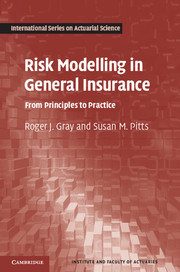Book contents
- Frontmatter
- Contents
- Preface
- 1 Introduction
- 2 Models for claim numbers and claim sizes
- 3 Short term risk models
- 4 Model based pricing – setting premiums
- 5 Risk sharing – reinsurance and deductibles
- 6 Ruin theory for the classical risk model
- 7 Case studies
- Appendix A Utility theory
- Appendix B Answers to exercises
- References
- Index
2 - Models for claim numbers and claim sizes
Published online by Cambridge University Press: 05 August 2012
- Frontmatter
- Contents
- Preface
- 1 Introduction
- 2 Models for claim numbers and claim sizes
- 3 Short term risk models
- 4 Model based pricing – setting premiums
- 5 Risk sharing – reinsurance and deductibles
- 6 Ruin theory for the classical risk model
- 7 Case studies
- Appendix A Utility theory
- Appendix B Answers to exercises
- References
- Index
Summary
In a portfolio of general insurance risks, such as a portfolio of motor insurance policies, two obvious quantities of interest are the number of claims arriving in a fixed time period and the sizes of those claims. We model these quantities as random variables with appropriate probability distributions, and this modelling process is the subject of this chapter.
There are many probability distributions available as potential models for both claim numbers and claim sizes in general insurance. Suitable models for claim numbers are “counting distributions”; that is, distributions of discrete random variables that can assume some or all of the values in ℕ = {0, 1, 2, …}. The most suitable and widely used models for claim sizes are distributions of continuous random variables that assume positive values only and have “fat tails” (or “heavy tails”), that is distributions which allow for occasional occurrences of very large values.
In this chapter we consider the principal models used in practice. We review the properties of the distributions one by one, illustrate how they are fitted to data on claim numbers and sizes, and consider how we assess the success of the models in reflecting the variation and distribution of the data.
In §2.1 and §2.2 we give summaries of the relevant properties of the various distributions – our aim is that these two sections will provide a useful reference for the reader, and will also fix notation for these distributions. In §2.1 we consider three families of counting random variables used as models for claim numbers, namely the one-parameter Poisson family, the two-parameter negative binomial family (which includes the one-parameter geometric subfamily), and the two-parameter binomial family. In this section, we also include a discussion of the Poisson process.
- Type
- Chapter
- Information
- Risk Modelling in General InsuranceFrom Principles to Practice, pp. 11 - 89Publisher: Cambridge University PressPrint publication year: 2012



